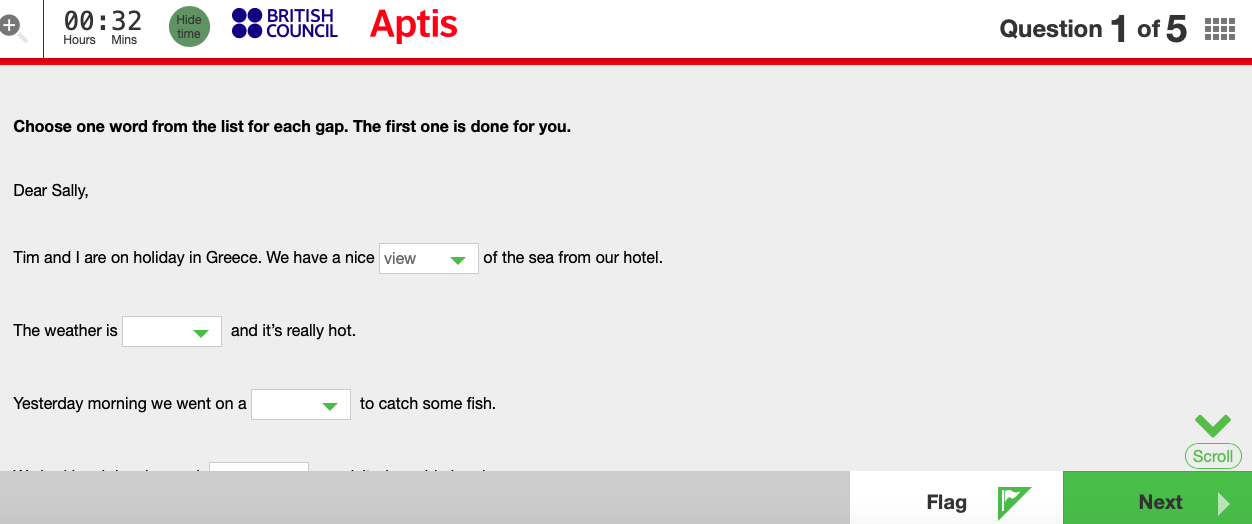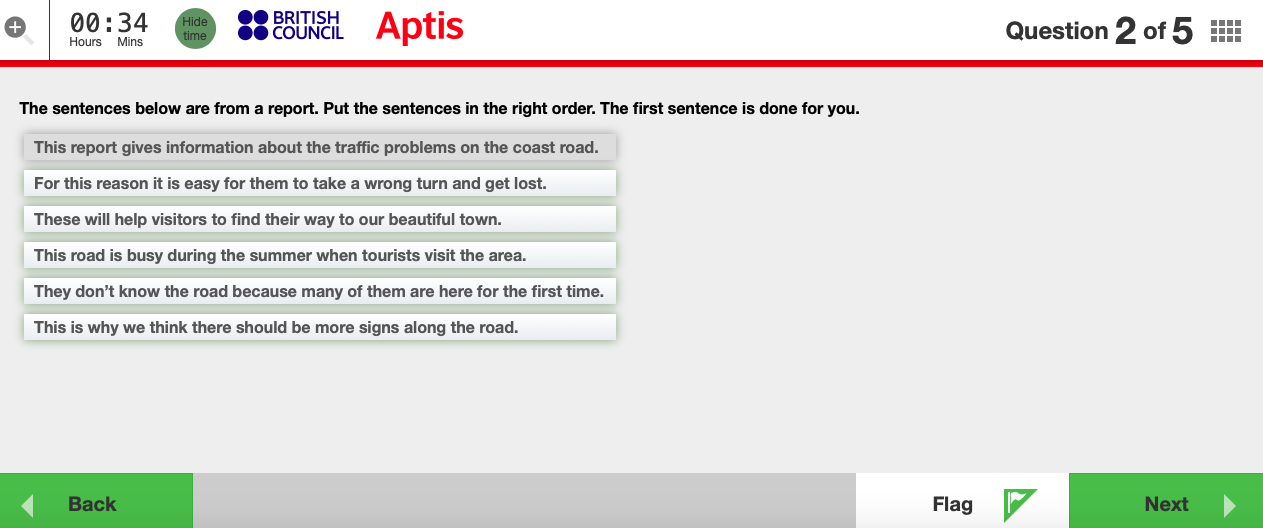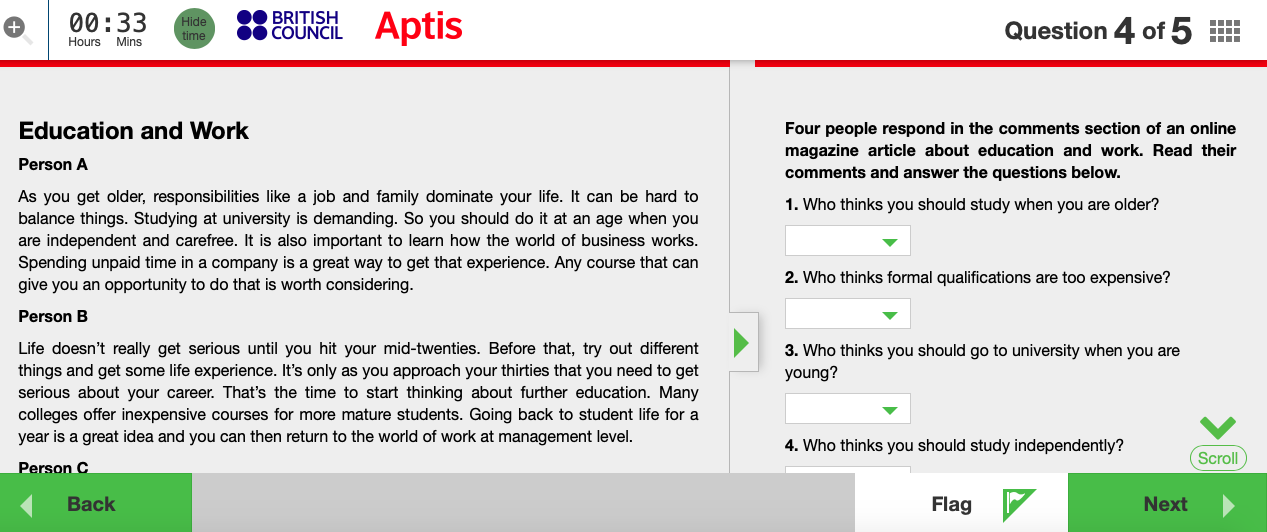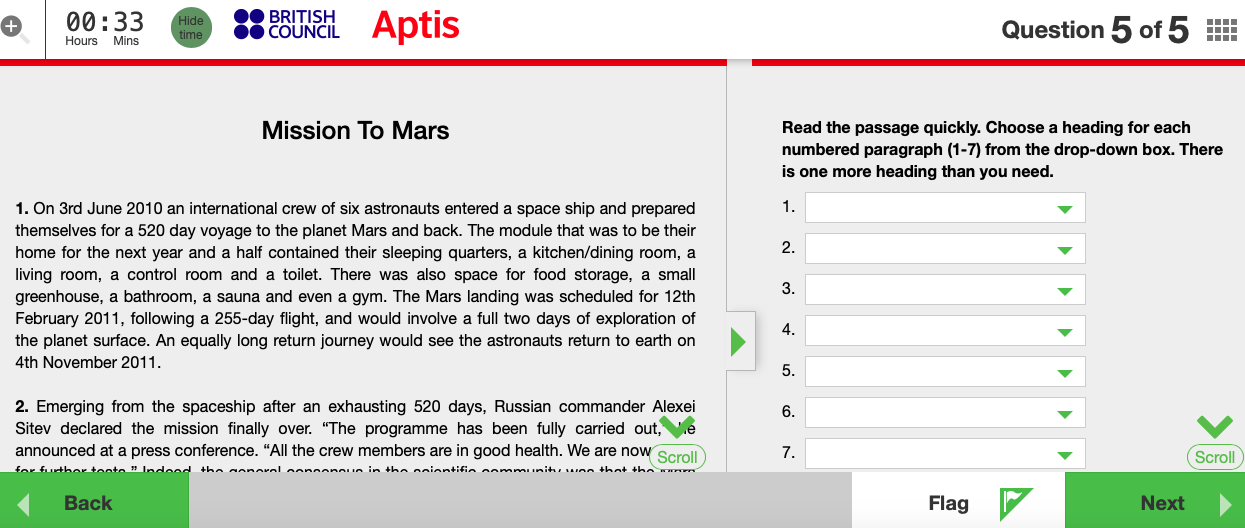APTIS Reading trucos
/Esta skill se compone de 4 partes y tienes 35 minutos en total para realizar toda la prueba. Como consejo te recomendamos que comiences con las partes más difíciles (la última parte es la que más os cuesta) o en su defecto no entreteneros mucho en la primera o tercera parte que son las más fáciles.
En primer lugar encontraremos un texto corto de unas pocas líneas al que le faltan palabras. Tendremos tres opciones por cada hueco para elegir cuál es la palabra que mejor encaja en esos espacios en blanco.
La segunda parte consiste en dos textos, también bastante corto, que aparecen divididos en frases o pequeños párrafos y desordenados. Deberemos volver a poner cada frase en el orden original para que la historia cobre sentido.
En la tercera parte te encontrarás con 4 textos correspondientes a 4 personas y 7 preguntas debajo. En cada pregunta se te pedirá que digas qué persona ha expresado qué idea.
En cuarto lugar y finalmente, tendremos que asociar unos títulos o encabezados a los distintos párrafos de un mismo texto. Este es el texto más largo, ocupando aproximadamente página y media de duración. También es habitual que tengamos uno o dos encabezados de sobra.
1ª Parte Reading Aptis
La primera parte se compone de un texto corto en el que tienes que rellenar una serie de huecos con 3 opciones para cada uno de ellos, el típico ejercicio de fill in the gaps. Suele tener 5 frases con un hueco para completar.
A continuación os dejamos un ejemplo tipo (adaptado de la guía del candidato del British Council):
Dear Mum and Dad,
Hello from sunny Brighton!Pete and I are here on holiday and _____ (having/getting/making) a great time.
There’s a lot to do and eat here-the fish are _____ (usual/great/well).
We went to see a film and _____ (saved/liked/tried) some of the local food.
Pete hadn’t been feeling very well, so it’s good for him to _____ (take/give/go) a real break.
He wants to get some exercise _____ (while/and/that) we’re on holiday.
As you ____ (know/hear/think), he loves quiet places and I hope it’s not too hot!
Love,
Helen.
2ª Parte Reading Aptis
La segunda parte del modelo Aptis General 2020 tiene 2 tareas. En esta parte, que es la de ordenar la historia, te presentan dos textos cortos formados por frases que componen una historia y aparecen desordenados, tu tarea es ordenar las frases. Normalmente te dan la primera de ellas como ayuda. Cada uno de los textos tendrá formado por 6 frases.
A continuación os dejamos un ejemplo tipo, la primera frase es con la que se empieza:
aptis Reading part 2 text 1
aptis Reading part 2 text 2
TEXT 1:
A) Emanuel Rugasira is an Uganda businessman. Then years ago he decided to start his own business.
B) He stopped selling beans to Westerns companies and started making coffee himself.
C) At that time, Ugandan coffee farmers made money by selling coffee beans to Western companies, who then made coffee and sold it to supermarkets.
D) But after ten years he has finally succeeded.Africans need more confidence in their business ideas.
E) At first it was very difficult for British and American supermarkets to buy his coffee.
F) Emanuel thought that was wrong and he believed that farmers didn’t earn enough money.
TEXT 2:
A) When this bank was founded in 1695, Scots coinage was in short supply and of uncertain value, compared with English, Dutch, Flemish or French coin.
B) In most countries it is only the government, through their central banks, who are permitted to issue currency.
C) To face growth of trade it was deemed necessary to remedy this lack of an adequate currency.
D) But in Scotland three banks are still allowed to issue banknotes.
E) The first Scottish bank to do this was the Bank of Scotland.
(Adaptado de un ejercicio de Cambridge)
3ª Parte Reading Aptis
La tercera parte del reading del examen Aptis General 2020 es un ejercicio típico de “quién dijo qué/piensa qué”. Este ejercicio se llama “opinión matching”, en el aparecen 4 opiniones (textos cortos) de 4 personas y una serie de preguntas en las que tienes que decir quien de esas 4 personas es la que opina eso.
aptis Reading part 3
A continuación os dejamos un ejemplo tipo elaborados por el salon de idiomas:
PERSON A)
This person is often referred to as a «crazy» scientist, with the implication that he is a rogue, a bad boy of biology. Yet it is the strict dictionary definition of the word that suits him best: a person of independent or unorthodox views. And when it comes to addressing the world’s environmental problems that may be just what we need.
As the head of various firms and institutes, some public and some private, this scientist has ambitious plans for the planet. By using the power of microbes that his scientists have discovered deep in the sea and under the ground, he believes we could revolutionise fuel production and bring down emissions.
PERSON B)
This person is the only anti-McDonald’s activist who has been welcomed to the offices of David Cameron, David Miliband, Prince Charles, Al Gore and Barack Obama. The founder of the international Slow Food movement is idolised by rich and leisured foodies for promoting high-quality, small-scale farming and organising a relaxed life around long lunches. But this person, an Italian leftie of the old school, has a far more serious purpose. The Slow Food movement has now expanded across 100 countries and is throwing poisoned darts at the whole fast food culture and the multinational food producers that between them have wrecked so much of the environment.
PERSON C)
This person is a UK-trained biologist who runs Ethiopia’s environment protection agency and has proved himself an extraordinarily effective negotiator. At 2am at the 2002 Earth Summit, he made one of the most impassioned speeches heard at a global meeting. It had looked certain that the world’s politicians would back a US proposal giving the World Trade Organisation the power to override international environment treaties, but he shamed the ministers into voting it down. No one could remember a personal intervention having such an impact, and his battles on behalf of developing countries to protect them from patents, unfettered free trade and GM crops are legendary.
PERSON D)
This person is the young BBC camerawoman who went to an atoll in Hawaii, found wildlife dead or dying after ingesting bits of plastic, and returned to the small town of Modbury in Devon with a fine film, and a desire to try to ban plastic bags. In May 2007, the town became the first in Europe to go plastic-free driven by their own initiative and since then at least 80 other places have decided to follow suit. London Councils, the umbrella group for 33 local authorities, aims to reduce the 4bn plastic bags sent to landfill from the capital each year and has proposed a law that would force shoppers to use their own bags or buy reusable ones at the tills.
Who thinks local initiatives can have a large extent on the citizens?
What person thinks that pollution can be dramatically changed with bacteria?
Which one of them thinks that changing a culture will help the environment?
Who thinks that convincing the politicians will help be more eco-friendly?
Who believes that the typical food chains are damaging the environment?
What person believes that using non-conformist science is an effective way of fighting against pollution?
Who claims that the pressure of local people can change policies?
4ª Parte Reading Aptis
aptis Reading part 4
La cuarta parte del examen Aptis General es la de matching headings, en la cual tienes 7 párrafos cortos y 8 títulos para enlazar, uno de los títulos sobra. Esta es la parte que más os cuesta con diferencia, os dejamos a continuación un ejemplo para que lo practiquéis:
Enlightenment ideas
Devoted to the American cause
Mercenary soldiers from Europe
French withdrawal from North America
Impossible to remain neutral
A valuable support and new expectations
George Washington’s heritage
Undercover support
A.
From thepoint of view of some Europeans, the American Revolution pitted the ideals of the Enlightenment, republicanism, and democracy against Europe’s established order, as exemplified by Britain. Some countries found that watching wasn’t enoughthey joined the fight.
B.
One of these countries was France. Without France, a very important ally of the United
Statesin the Revolutionary War, the U.S. might not have defeated the British army. The French supported the colonists for a number of reasons. A weakened England could only heighten France’s status and influenceboth in Western Europe and around the world as various countries competed to establish colonies. Some French may have been seekingpayback: only twelve years before the American Revolution, Francewas at war with Britain in the Seven
Years’ War, and they lost.This resulted in France being forced to giveNorth American territories to Britain.
C.
Five months after the Declaration of Independence was signed, Benjamin Franklin travelled to Paris. He hoped to explain the colonialcause to the French, and enlist their support. Franklin was already popular in France for his writings and scientific discoveries, and he was successfully able to secure French support. At first, France supported the colonists only in secret. Gunpowder, ammunition, weapons, and money were smuggled into the country, hidden in commercial ships. Military strategists crossedthe Atlantic to advise Continental Armymilitary commanders.
D.
In February 1778, France officially recognized the United States(following the Battle of Saratoga, in which the Continental Army decisively defeated the British army and gave a resurgence of hope to the colonists’ fight for independence), and the countries signed an alliance. French soldiers fought alongside colonists; French and British fleets clashed from Rhode Island down to Georgia. In addition to manpower, France contributed money and weapons. In total, France spentthe equivalent of $13 billion helping the colonialcause.
E.
Spain also supported the colonists. First, like France, the Spanish contribution consisted of money and weapons. But in 1779, Spain joined France withmilitary support. Also like France, the Spanish navy played an important role in combatting the formidable British fleet. Land and sea battles were sometimes fought far from the colonies, in the Mediterranean, the West Indies,and West Africa. But French, Spanish, and Colonial armies were not only fighting the British. A quarter of all soldiers under the British flag were actually from the area known as Germany Today30,000 hired men in all. These soldiers were known as Hessians, because many of them were from the independent principality of HesseCassel.
F.
Native Americans also fought in the American Revolution. Most considered colonists to be a threat to their territory, and so they fought on the British side. In total, approximately 13,000 Native Americans fought against the colonists. But some Native Americans fought with the colonists. The Revolution was, for them, a controversial and divisive matter. For instance, the Iroquois Confederacy, also known as the Six Nations, was a powerful organization of tribes that tried to stay neutral. But pressed to choose a side, the Confederacy could reach no agreement; it split up, with two tribes pledging their allegiance to the colonists, and four to the British.
G.
Other notable figures were two men from Poland: Tadeusz Kosciuszko and Casimir Pulaski. TadeuszKosciuszko was born in Poland, moved to France, sailed to America, and rose to the rank of brigadier general. His countryman, Casimir Pulaski, has been called the “father of the American cavalry.” Pulaski organized and trained the Continental Army’s horsemen, which had been used mostly for scouting. Pulaski was also promoted to general, but was killed in the war. Pulaski and Kosciuszko joined the colonists out of idealism. They believed in the struggle for freedom and self-governance. As Pulaski wrote to George Washington after his arrival in Massachusetts, “I came here, where freedom is being defended, to serve it, and to live or die for it.”
RELLENA TUS DATOS Y TE MANDAMOS LAS RESPUESTAS :)







